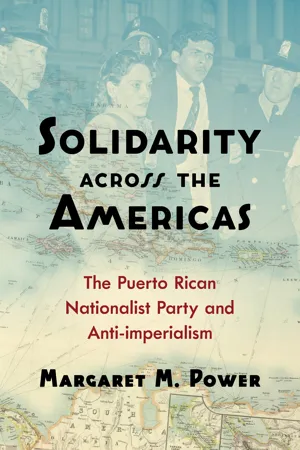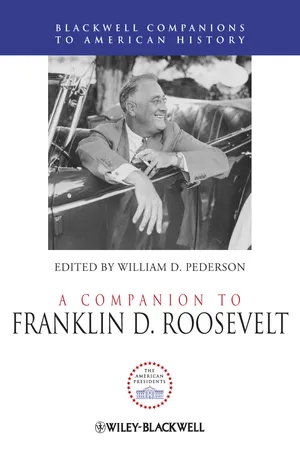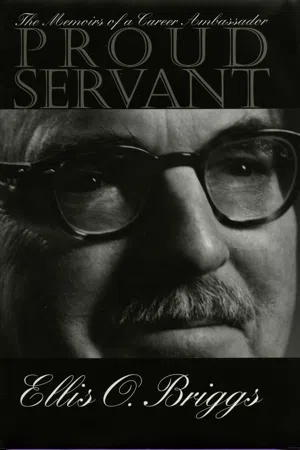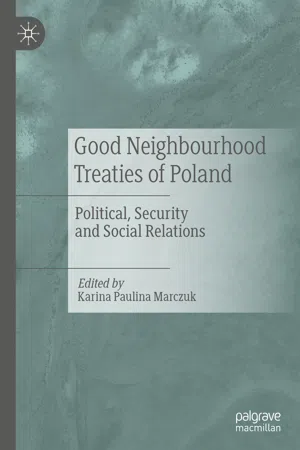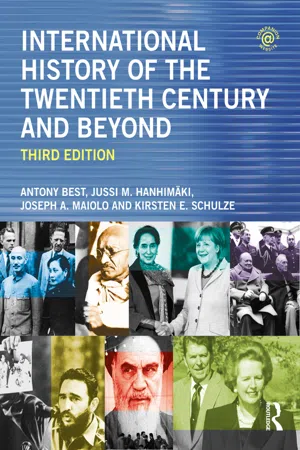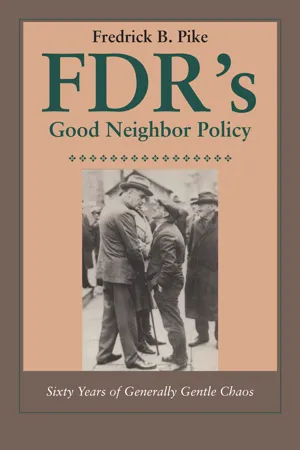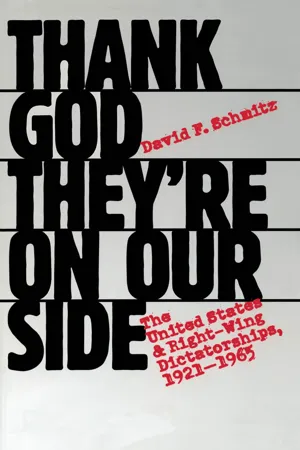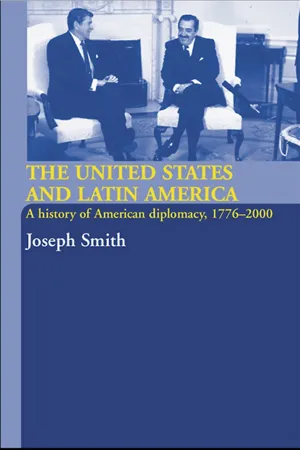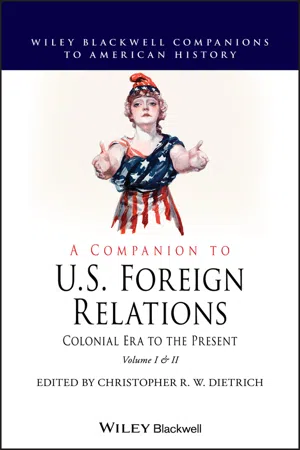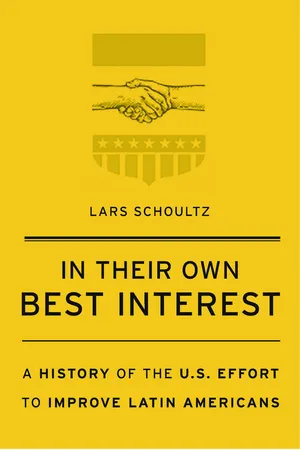History
Good Neighbour Policy
The Good Neighbor Policy was a foreign policy initiative introduced by U.S. President Franklin D. Roosevelt in the 1930s. It aimed to improve relations with Latin American countries by promoting non-intervention and cooperation. The policy sought to replace the previous interventionist approach with a more respectful and cooperative relationship, emphasizing mutual respect and non-interference in the internal affairs of other nations.
Written by Perlego with AI-assistance
Related key terms
10 Key excerpts on "Good Neighbour Policy"
- eBook - ePub
Solidarity across the Americas
The Puerto Rican Nationalist Party and Anti-imperialism
- Margaret M. Power(Author)
- 2023(Publication Date)
- The University of North Carolina Press(Publisher)
6The Good Neighbor Policy developed, in part, to ensure that Latin America would be a firm ally and provide a safe and reliable “backyard” in the upcoming war with Germany and Italy. As Justin Hart notes in reference to the Inter-American Peace Conference held in Buenos Aires in December 1936, at which Roosevelt reaffirmed the United States’ commitment to nonintervention in Latin America, “the specter of German rearmament and territorial expansion hung over the proceedings,” a perception that sharpened Washington’s determination to maintain good relations with governments throughout the hemisphere.7 Furthermore, dictatorships friendly to the United States, such as Rafael Trujillo in the Dominican Republic and Anastasio Somoza in Nicaragua, ruled much of Latin America. They had strong economic ties to the United States, which reduced the need for U.S. military intervention. Finally, British and French imperial power in the region had fallen steadily since World War I, which made the moment a propitious one for the United States to proclaim a policy based on mutual respect.8The Good Neighbor Policy not only reflected U.S. needs but also responded to the demands of Latin Americans to end foreign intervention in the region. At the Seventh International Conference of American States in Montevideo in 1933, every American nation, with the exception of Bolivia, agreed, “No state has the right to intervene in the internal or external affairs of another.”9 Delegates to the Inter-American Peace Conference in Buenos Aires extended and strengthened the nonintervention agreement of 1933 by pledging that their countries would resolve conflict with “pacific solutions.”10President Roosevelt attended the conference. He made the long journey to Buenos Aires by ship to assure Latin Americans that the U.S. government intended to fulfill its promises to respect regional sovereignty as set forth in the Good Neighbor Policy. Argentine president Augustín Justo went overboard to welcome the U.S. president. He decreed the day Roosevelt arrived a holiday and announced, “All the railroads will run special excursion trains to Buenos Aires for the occasion.”11 Roosevelt received a hero’s greeting when he arrived; throngs of people lined the streets of the Argentine capital and cheered him as his car passed.12 - eBook - ePub
- William D. Pederson, William D. Pederson(Authors)
- 2011(Publication Date)
- Wiley-Blackwell(Publisher)
Chapter Twenty-Eight THE GOOD NEIGHBOR POLICY AND THE AMERICAS Michael R. Hall The Good Neighbor policy is the term commonly ascribed to American foreign policy toward the 20 independent nations of Latin America during the administration of Democratic President Franklin D. Roosevelt (1933–45). One could argue, however, that the Good Neighbor policy had its origins during the presidencies of Republicans Calvin Coolidge and Herbert Hoover (1923–33). Significantly, it was Hoover, during a 10-country tour of Latin America after his election in 1928 and before his inauguration in 1929, who first used the phrase in connection with American foreign relations toward Latin America. One could also argue that the spirit of the Good Neighbor policy, especially as it related to overt American military intervention in Latin America, was upheld until the 1965 US military intervention in the Dominican Republic during the presidential administration of Democratic President Lyndon B. Johnson. Regardless of when the Good Neighbor policy actually began and ended, this chapter is dedicated to an analysis of the Good Neighbor policy during Roosevelt’s presidency. In addition to examining the implementation of the Good Neighbor policy in individual Latin American nations, this chapter will reveal the primary schools of historical interpretations of the Good Neighbor policy by contemporary historians, guide students to primary and secondary sources concerning the Good Neighbor policy, and (perhaps most importantly) point out areas that require more research to more fully understand Roosevelt’s foreign policy toward Latin America. Historiography In 1961, historian Bryce Wood published The Making of the Good Neighbor Policy. Wood’s book, the first systematic study of the origins of the Good Neighbor policy, is still regarded by many scholars as the standard interpretation - eBook - ePub
Proud Servant
The Memoirs of a Career Ambassador
- Ellis Briggs(Author)
- 2011(Publication Date)
- The Kent State University Press(Publisher)
11Good Neighbors
The Good Neighbor Policy was unveiled by President Roosevelt in his inaugural address in 1933. Roosevelt declared that his administration would be guided by the good neighbor, “the neighbor who resolutely respects himself, and because he does so, respects the rights of others.” Roosevelt’s prestige remained high in Latin America throughout his years in office.At that time the Neighbors numbered twenty countries, plus the United States, loosely joined in an organization then called the Pan American Union, with headquarters in an elegant marble palace on lower 17th Street, a few blocks south of the State Department.The eighteen Spanish-speaking countries, Brazil (half the South American continent), and Haiti were preoccupied with problems of development, social and economic maladjustments, inflation, explosive population growth, and an increasing resentment on the part of the indigenous poor directed against those controlling the wealth of each nation. Local political leaders unable to solve their problems were not averse to blaming the Colossus of the North for alleged sins of omission (called “taking Latin America for granted”) and also of commission (called “intervention,” and after intervention, “colonialism”).The fact that relations with Latin America during most of our history have rarely been of paramount importance to the United States does not mean that the Neighbors have been neglected. From 1933 until his resignation in 1944, Secretary Hull took a lively if intermittent interest in the hemisphere. He dutifully attended board meetings at the Pan American Union, listening patiently to whispered translations of interminable speeches. He enjoyed heading American delegations at inter-American conferences (e.g., Montevideo in 1933, Lima in 1938, and Havana in 1940). And as his memoirs attest, the problems of such countries — in particular, Cuba, Argentina, Brazil, and Mexico — often engaged his most diligent interest. On routine matters, however, as well as on many fundamental issues, Hull was content to leave decisions to Undersecretary of State Sumner Welles, who spoke Spanish and was diligent, hardworking and sympathetic to many of the Latin American aspirations. In addition, Welles had easy access to the White House; he was personally closer to the president than was his secretary of state. - eBook - ePub
Good Neighbourhood Treaties of Poland
Political, Security and Social Relations
- Karina Paulina Marczuk, Karina Paulina Marczuk(Authors)
- 2019(Publication Date)
- Palgrave Macmillan(Publisher)
Part I Poland’s Good Neighbourhood PolicyPassage contains an image
© The Author(s) 2019Begin AbstractK. P. Marczuk (ed.)Good Neighbourhood Treaties of Poland https://doi.org/10.1007/978-3-030-12615-5_22. Foundations of the Good Neighbourhood Policy of the Republic of Poland
English language translation by Anthony Sloan. End AbstractDariusz Popławski1(1) Faculty of Political Science and International Studies, Institute of International Relations, University of Warsaw, Warsaw, PolandIntroduction
The good neighbourhood policy constitutes part of foreign policy and concerns bilateral relations. In the literature on the subject, though, it is not defined unambiguously. It is usually given a political dimension, and its purpose is to develop and deepen particularly beneficial bilateral relations between states. In the general sense, good neighbourhood policy is defined geographically and most often concerns ‘next door’ neighbours. Yet the term has also been applied more broadly, in the sub-regional and regional contexts, which is a clear reference to the colloquial terms ‘immediate neighbourhood’ and ‘remote neighbourhood’. Good neighbourhood policy is addressed towards states and nations seeking to shape their bilateral relations. Its beginnings relate to the sovereign principle of equality among states formulated after the First World War (Popławski, 2016a , p. 95).While, of course, earlier examples exist of friendly relations between partners, in such cases it is difficult to speak of good neighbourhood policy in today’s meaning of the term. Before modern times, relations most often existed between sovereigns. We can speak of international relations from the moment nation-states came into being. From antiquity, peaceful relations between sovereigns were described using the terminology of family relationships, for example, fraternal relations between equal rulers or filial relations in the case of various forms of dependence. Family models were also applied in diplomacy, when a high-ranking diplomatic envoy was treated as a younger brother. Even in the Treaty of the Holy Alliance, reference is made to genuine ties and an inviolable brotherhood between the leaders of Russia, Austria, and Prussia (Polk, 2000 , pp. 42–43). Gradually, though, in declarations and reports on visits abroad, the term ‘family’ is replaced or supplemented with other terms derived from the category of ‘friendship’.1 - Available until 20 Sep |Learn more
- Antony Best, Jussi M. Hanhimäki, Joseph A. Maiolo, Kirsten E. Schulze(Authors)
- 2014(Publication Date)
- Routledge(Publisher)
Gellman, Good Neighbor Diplomacy (Baltimore, MD, 1979), Michael Grow, The Good Neighbor Policy in Paraguay (Lawrence, KS, 1981), Stephen J. Randall, The Diplomacy of Modernization: Colombian–American Relations, 1920–1940 (Toronto, 1977), Dana G. Munro, The United States and the Caribbean Republics, 1921–1933 (Princeton, NJ, 1974), G. Pope Atkins and Larman C. Wilson, The United States and the Trujillo Regime (New Brunswick, NJ, 1972), Randall B. Woods, The Roosevelt Foreign Policy Establishment and the ‘Good Neighbor’ (Lawrence, KS, 1980) and Eric Paul Roorda, The Dictator Next Door (Durham, NC, 1998). David Schmitz provides a comparative analysis of US policy towards right-wing dictatorships from the inter-war years to the 1960s in Thank God They’re On Our Side: The United States and Right-Wing Dictatorships, 1921-1965 (Chapel Hill, NC, 1999). For US economic influence in Latin America, see Thomas O’Brien, The Revolutionary Mission: American Enterprise in Latin America, 1900-1945 (Cambridge, 1996). Franklin Roosevelt and the Second World War is the subject of numerous accounts of which the most detailed are Robert Dallek, Franklin D. Roosevelt and American Foreign Policy, 1932–1945 (New York, 1979), Robert A. Divine, Roosevelt and World War II (Baltimore, MD, 1969) and Warren Kimball, The Juggler (Princeton, NJ, 1992). For the role of Latin American countries in the Second World War and American policy, see Michael J. Francis, The Limits of Hegemony (Notre Dame, IN, 1977), Frank D. McCann, The Brazilian–American Alliance (Princeton, NJ, 1973), Stanley Hilton, Hitler’s Secret War in South America, 1939–1945 (Baton Rouge, LA, 1981), Max Paul Friedman, Nazis and Good Neighbors: The United States’ Campaign Against the Germans of Latin America in World War II (Cambridge, 2003) and Thomas M. Leonard, John F. Bratzel, George Lauderbaugh and Andrew Lefebvre, Latin America During World War II (New York, 2006). - eBook - ePub
FDR's Good Neighbor Policy
Sixty Years of Generally Gentle Chaos
- Fredrick B. Pike(Author)
- 2010(Publication Date)
- University of Texas Press(Publisher)
SECTION VLaunching and Targeting the Good Neighbor PolicyPassage contains an image
16. Discarding the Burdens of InterventionismRoosevelt and Nonintervention: The Trickster in His ElementIn constructing a Good Neighbor policy, nonintervention was a key building block. Through his personal touch Franklin Roosevelt shaped and polished that building block. As a refined gentleman who prided himself on elegant manners, he was loathe to give overt offense. And in the 1930s, Latin Americans professed to find virtually no facet of Yankee behavior more offensive than overt intervention in their internal affairs. But far more than reluctance to give offense lay behind FDR’s espousal of nonintervention in hemispheric affairs. Roosevelt was also looking for positive, tangible payoffs—tantamount to the payoffs he garnered from voters in the American South by refusing to intervene in what they regarded exclusively as internal affairs.Roosevelt helped strengthen the Democratic hold on the “Solid South” through his willingness to allow the area’s white electorate a free hand in establishing the parameters of race relations. Similarly, he helped bring about a more harmonious hemisphere through his willingness to allow Latin Americans greater freedom than previous Washington administrations had accorded them in setting the terms of their relationship to Yankee capitalists. With his highly developed sense of reciprocity, of the niceties of tit-for-tat relationships, Roosevelt expected Latin Americans to respond to concessions he extended them as generously as white voters in the American South had responded. He expected Latin Americans to indicate their appreciation for favors extended by keeping the door open to American capitalists, at least to those good-mannered capitalists willing to conduct themselves according to the more demanding code about to be prescribed by New Dealers. - eBook - ePub
Thank God They're on Our Side
The United States and Right-Wing Dictatorships, 1921-1965
- David F. Schmitz(Author)
- 2009(Publication Date)
- The University of North Carolina Press(Publisher)
The Roosevelt administration again accepted the Republican answer to the difficult problem of providing stability without direct American military intervention. Moreover, it was clear that while the United States nominally supported democracy and hoped to promote and protect it internationally, Washington was more concerned with instability and the danger of freedom in what it perceived to be politically immature nations. The key to development anywhere was order, which would minimize distress during difficult periods of transition to modern economic and, eventually, political states. Until then, evidence indicated that strong rule was necessary in many nations to ensure that they did not attempt self-rule until they were free of the dangers from the left. The United States would support authoritarian rulers as long as order was preserved, they did not form alliances with any power that threatened the United States, and investments and trade were protected. The policy pendulum had swung fully to a position of support for right-wing dictators.Good Neighbor Batista
During his inauguration speech on 4 March 1933, Roosevelt announced that U.S. relations with the other American republics would be based on the “policy of the good neighbor . . . who resolutely respects himself and, because he does so, respects the rights of others.”108 Sumner Welles, an old friend of Roosevelt’s, who would oversee the establishment of this policy, had recommended to the newly elected president that his top priority should be “the creation and maintenance of the most cordial and intimate friendship between the United States and other republics of the American continent.”109 Seeking to improve relations with Latin America so as to increase international trade, aid economic recovery at home, and forestall unrest, the administration renounced the use of unilateral American intervention in the affairs of those nations. The announcement of the Good Neighbor Policy received a positive reception on both sides of the Rio Grande. The seemingly bold declaration was in reality a continuation of Stimson’s policy of ending direct American intervention while still preserving influence and stability. Only the methods, not the desired objectives of influence and stability, had changed.Roosevelt’s desire to end military intervention was similar to Stimson’s. As early as 1928, he had stated that “single-handed intervention by us in the internal affairs of other nations must end; with the cooperation of others we shall have more order in this Hemisphere and less dislike.”110 The others too often turned out to be dictators. Roosevelt made his concerns clear in December 1933. He announced that the “definite policy of the United States from now on is one opposed to armed intervention.” The problem of order remained. Roosevelt backed away from Wilson and Hughes when he stated that the “maintenance of constitutional government in other nations is not a sacred obligation devolving upon the United States alone.” He then slightly shifted the central concern when he noted that “the maintenance of law and the orderly processes of government in this hemisphere is the concern of each individual nation.”111 - eBook - ePub
The United States and Latin America
A History of American Diplomacy, 1776-2000
- Joseph Smith(Author)
- 2005(Publication Date)
- Routledge(Publisher)
Despite Hoover’s good intentions, his administration did not witness a tangible improvement in inter-American relations or understanding. In fact, the amount of actual contact was arguably diminished because economic relations between Latin America and the United States were adversely affected by the depression. From 1929 to 1933 American exports to the region fell in value by more than 75 per cent, while imports declined by 68 per cent. In addition, the United States appeared decidedly unsympathetic to the economic plight of Latin American exporters because domestic political reasons dictated the maintenance of a strongly protectionist attitude that was symbolized by the passage in the US Congress of the Smoot- Hawley Tariff in 1930. While the onset of the Great Depression contributed to diplomatic uncertainty and undermined inter-American relations, it also marked a definite historical watershed for the United States. This occurred in 1932 when Herbert Hoover’s electoral defeat brought an end to over a decade of Republican control of the White House and paved the way for the ‘New Deal’ of Franklin D. Roosevelt.Franklin D. Roosevelt and the ‘Good Neighbor Policy’
Latin Americans were apprehensive over the choice of a ‘Roosevelt’ as the Democratic candidate in the 1932 presidential election because that surname was firmly associated with the aggressive policy of the Big Stick. Unlike his cousin Theodore, however, Franklin D. Roosevelt publicly announced a desire to act sympathetically towards the Latin American nations.7 As president, he basically continued Hoover’s conciliatory policy although it now acquired a new and fresh name as a result of a section taken from Roosevelt’s inaugural address of 4 March 1933: ‘In the field of world policy, I would dedicate this nation to the policy of the good neighbor – the neighbor who resolutely respects himself and, because he does so, respects the rights of others.’8 Though never precisely defined, like many of his political slogans, the concept of acting as a ‘good neighbor’ was attractive in terms of external public relations because it implied equality and mutual respect among nations. It would be applied by Roosevelt not, as he initially seemed to suggest, to include the whole world but specifically to the countries of the Western Hemisphere. Consequently, it was Roosevelt and not Hoover who has been popularly regarded as the originator of what became known as the ‘Good Neighbor Policy’.9In his first few months in the presidency, Roosevelt’s actions belied his proclaimed good neighbourly intentions. One of his initial foreign policy crises was the island of Cuba which was in civil and economic disorder resulting mainly from the collapse in the world price of sugar and the severe decline of sugar exports to the United States. President Gerardo Machado, who had been in power since 1924, had adopted ruthless emergency powers and was eventually overthrown in a military coup in August 1933. In the ensuing uncertainty considerable political pressure was put on Roosevelt for American military intervention under the Platt Amendment to restore constitutional government. While Roosevelt duly sent a small number of warships to patrol Cuban waters and present a show of military force, he would not order the landing of marines. ‘Despite the legal right we possessed’, Roosevelt’s secretary of state, Cordell Hull, later explained, ‘such an act would further embitter our relations with all Latin America.’10 - eBook - ePub
A Companion to U.S. Foreign Relations
Colonial Era to the Present
- Christopher R. W. Dietrich, Christopher R. W. Dietrich(Authors)
- 2020(Publication Date)
- Wiley-Blackwell(Publisher)
2013 ).One strain of the cultural school is a sort of throwback to the nationalist‐paternalist school of Bemis. This school argues that the United States needs to improve Latin America by exporting U.S. values there. Two representative works include Lawrence E. Harrison's The Pan American Dream: Do Latin America's Cultural Values Discourage True Partnership with the United States and Canada? (1998 ) and Steven Schwatzberg's Democracy and U.S. Policy in Latin America During the Truman Years (2003 ), which discusses U.S. attempts to foster democracy in Latin America in the early Cold War. Harrison's book is more “preachy,” insisting that U.S. leaders need to be more assertive in spreading U.S. values such as hard work, thriftiness, and community‐mindedness to Latin America lest it be doomed to be mired in poverty‐infused stasis. Schwarzberg's book, focused thematically on democracy in the immediate post‐World War II era, is more analytical. Both reveal that Bemis's influential work continues to cast a long shadow over half a century later. It is important to note, too, that U.S. officials in Washington, D.C. probably share a great many of the views of this type of cultural analysis of U.S.–Latin American relations.Examining U.S.–Latin American relations from a very different political perspective is Jules R. Benjamin's “The Framework of U.S.–Latin American Relations in the Twentieth Century: An Interpretive Essay” (1987 ), which discusses how U.S. leaders aimed to export U.S. values and culture to Latin America. Benjamin attributes to these U.S. leaders an almost missionary impulse to build up a larger and stronger middle class in Latin America, and to make that middle class more like the United States' own. A less polemical work is Frederick Pike's Latin America and the United States (1992 - eBook - ePub
In Their Own Best Interest
A History of the U.S. Effect to Improve Latin Americans
- Lars Schoultz(Author)
- 2018(Publication Date)
- Harvard University Press(Publisher)
IN 1923 THE delegates at Santiago had agreed to hold these conferences at five-year intervals—in 1928 at Havana and now at Montevideo in 1933, nine months after FDR’s inauguration. This was the seventh such meeting, but the first where the U.S. delegation was led by the secretary of state, Cordell Hull, and everyone understood that the Good Neighbor would be asked to agree to the resolution the United States had twice opposed: “No state has the right to intervene in the internal or external affairs of another.”“I desire most heartily to second the motion to report this resolution favorably,” Secretary Hull told the committee handling the proposal. “The people of my country strongly feel that the so-called right of conquest must forever be banished from this hemisphere,” and at a plenary session a few days later he reiterated that “no government need fear any intervention on the part of the United States under the Roosevelt Administration.” But then he added a disappointing reservation: the United States would follow “the law of nations as generally recognized and accepted.” That provided all the wiggle room Washington might ever need, and the conference ended with delegates wondering what they had accomplished.41They were reassured two days later, when FDR, speaking from Washington, pledged that “the definite policy of the United States from now on is one opposed to armed intervention,” a commitment he seemed to broaden a few days later in his first State of the Union address: “We have, I hope, made it clear to our neighbors that we seek with them future avoidance of territorial expansion and of interference by one nation in the internal affairs of another.” After that, few could disagree with what FDR told a 1935 audience: “I am a good neighbor.”42And even the unconvinced few had to concede a year later, when the president sailed for Buenos Aires to attend the first of several special inter-American meetings focused on the war clouds gathering in Europe. The Argentines gave FDR a regal reception, and the ensuing 1936 Buenos Aires conference tied down Cordell Hull’s conditional commitment at Montevideo while also substantially broadening the definition of intervention beyond the use of armed force: “The High Contracting Parties declare inadmissible the intervention of any one of them, directly or indirectly, and for whatever reason, in the internal or external affairs of any other of the Parties.” The U.S. delegation signed, the Senate ratified, and that was that.43
Index pages curate the most relevant extracts from our library of academic textbooks. They’ve been created using an in-house natural language model (NLM), each adding context and meaning to key research topics.
